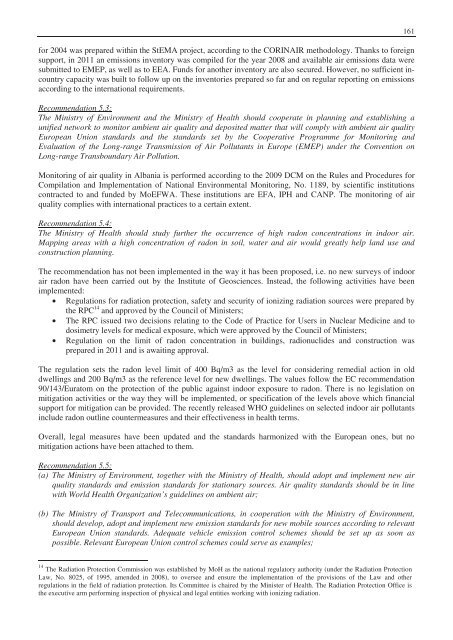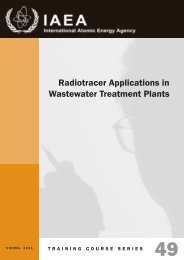Second Environmental Performance Review of Albania
Second Environmental Performance Review of Albania
Second Environmental Performance Review of Albania
You also want an ePaper? Increase the reach of your titles
YUMPU automatically turns print PDFs into web optimized ePapers that Google loves.
for 2004 was prepared within the StEMA project, according to the CORINAIR methodology. Thanks to foreignsupport, in 2011 an emissions inventory was compiled for the year 2008 and available air emissions data weresubmitted to EMEP, as well as to EEA. Funds for another inventory are also secured. However, no sufficient incountrycapacity was built to follow up on the inventories prepared so far and on regular reporting on emissionsaccording to the international requirements.Recommendation 5.3:The Ministry <strong>of</strong> Environment and the Ministry <strong>of</strong> Health should cooperate in planning and establishing aunified network to monitor ambient air quality and deposited matter that will comply with ambient air qualityEuropean Union standards and the standards set by the Cooperative Programme for Monitoring andEvaluation <strong>of</strong> the Long-range Transmission <strong>of</strong> Air Pollutants in Europe (EMEP) under the Convention onLong-range Transboundary Air Pollution.Monitoring <strong>of</strong> air quality in <strong>Albania</strong> is performed according to the 2009 DCM on the Rules and Procedures forCompilation and Implementation <strong>of</strong> National <strong>Environmental</strong> Monitoring, No. 1189, by scientific institutionscontracted to and funded by MoEFWA. These institutions are EFA, IPH and CANP. The monitoring <strong>of</strong> airquality complies with international practices to a certain extent.Recommendation 5.4:The Ministry <strong>of</strong> Health should study further the occurrence <strong>of</strong> high radon concentrations in indoor air. Mapping areas with a high concentration <strong>of</strong> radon in soil, water and air would greatly help land use and construction planning.The recommendation has not been implemented in the way it has been proposed, i.e. no new surveys <strong>of</strong> indoorair radon have been carried out by the Institute <strong>of</strong> Geosciences. Instead, the following activities have beenimplemented:• Regulations for radiation protection, safety and security <strong>of</strong> ionizing radiation sources were prepared bythe RPC 14 and approved by the Council <strong>of</strong> Ministers;• The RPC issued two decisions relating to the Code <strong>of</strong> Practice for Users in Nuclear Medicine and todosimetry levels for medical exposure, which were approved by the Council <strong>of</strong> Ministers;• Regulation on the limit <strong>of</strong> radon concentration in buildings, radionuclides and construction wasprepared in 2011 and is awaiting approval.The regulation sets the radon level limit <strong>of</strong> 400 Bq/m3 as the level for considering remedial action in olddwellings and 200 Bq/m3 as the reference level for new dwellings. The values follow the EC recommendation90/143/Euratom on the protection <strong>of</strong> the public against indoor exposure to radon. There is no legislation onmitigation activities or the way they will be implemented, or specification <strong>of</strong> the levels above which financialsupport for mitigation can be provided. The recently released WHO guidelines on selected indoor air pollutantsinclude radon outline countermeasures and their effectiveness in health terms.Overall, legal measures have been updated and the standards harmonized with the European ones, but nomitigation actions have been attached to them.Recommendation 5.5:(a) The Ministry <strong>of</strong> Environment, together with the Ministry <strong>of</strong> Health, should adopt and implement new airquality standards and emission standards for stationary sources. Air quality standards should be in linewith World Health Organization’s guidelines on ambient air;(b) The Ministry <strong>of</strong> Transport and Telecommunications, in cooperation with the Ministry <strong>of</strong> Environment,should develop, adopt and implement new emission standards for new mobile sources according to relevantEuropean Union standards. Adequate vehicle emission control schemes should be set up as soon aspossible. Relevant European Union control schemes could serve as examples;16114The Radiation Protection Commission was established by MoH as the national regulatory authority (under the Radiation ProtectionLaw, No. 8025, <strong>of</strong> 1995, amended in 2008), to oversee and ensure the implementation <strong>of</strong> the provisions <strong>of</strong> the Law and otherregulations in the field <strong>of</strong> radiation protection. Its Committee is chaired by the Minister <strong>of</strong> Health. The Radiation Protection Office isthe executive arm performing inspection <strong>of</strong> physical and legal entities working with ionizing radiation.
















